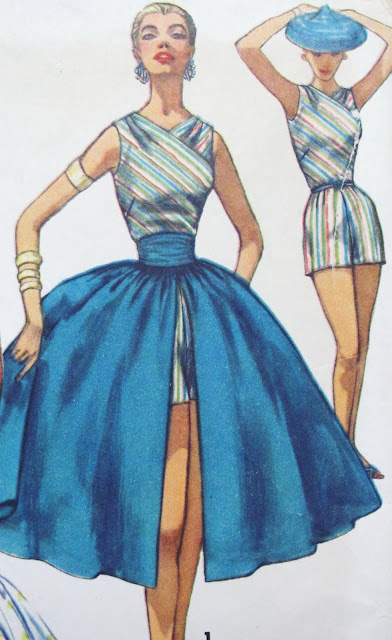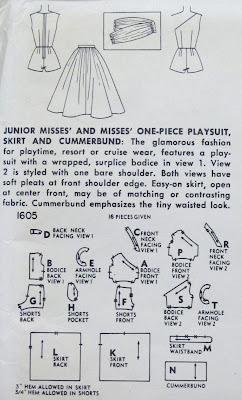
Sewing a 1950's vintage style summer play suit set is not has difficult as that may seem. When making vintage styles, sometimes you have to copy an idea, rather than use a pattern. This Simplicity Pattern 1605 dates from the 1950's. It has has a classic detachable skirt worn over a short playsuit.

The wrapped bodice seems strongly influenced by Claire McCardell and other American designers who were creating styles with an Indian sari influence. The jumpsuit image shows how the edge of a sari or border print could be used to create a dramatic diagonal on the one shoulder top.
For a sewing project, this outfit is worth taking a second look, especially for the wrapped neckline which can be made with or without the second shoulder panel. The easy to sew gathered skirt is accented by a detachable cummerbund. The skirt fastens in front and it acts as a cover-up for going indoors at the country club.

The back of the pattern shows how the pieces are cut. Even though this pattern is no longer available, it is possible to re-create the same look with a gathered skirt over a jumpsuit or shorts and halter top. Probably the easiest way to get a similar pattern is to create your own pattern hack. Using two Butterick patterns, this look could be created.
To sew your own wrap bodice and skirt, start with Butterick 6582. It has a great version of this wrapped bodice, but attached to a gathered skirt. Using this pattern, the surplice top could be used. When fitting it, be sure to determine your waistline, since that is where the shorts will be attached. If you want to make this a 'crop top' and not attach the shorts, that would be even easier to fit. Use this pattern for making the detachable skirt by sewing the fabric to a straight waistband that meets in the front. There should be a wide sash too that wraps around the waistline.
To make your shorts, use Butterick 5895. It is a well fit pant with a high 'natural' waistline. A fitting muslin would be the next step so that the best length for shorts can be drawn on the leg and transferred to the paper pattern. It would also be important to pin the bodice to the waistline so that the correct waistline is determined. You may want to lengthen or shorten the pant waistline at this time too.

This outfit would duplicate the one we see here, making it a great 50's style play suit for the summer!
This "Throw-back Thursday" post was adapted from the original posted July 13, 2011.




